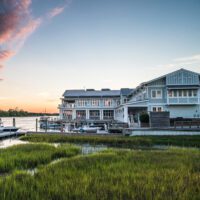
Reprinted from The Outer Banks Voice
After two hours of testimony from county officials and public hearing comments, a visibly frustrated Dare County Commissioners Chair Bob Woodard presented a motion to table any decision on an environmental zone of influence that borders Buxton Woods for 90 days, “so that we can study this and try to iron out exactly what we’ve been discussing.” The motion passed unanimously.
Supporter Spotlight
The discussion at the Monday meeting followed a recommendation from the Dare County Planning Board that the zone of influence in the SED-1 district should be removed from the county ordinances “based on consistency with the Dare County Land Use Plan.”
Created in 1988, the zone of influence includes an eight-mile-long area on the soundside of N.C. 12 from Frisco to the north end of Buxton. Written soon after Buxton Woods Reserve was founded in 1988, the zone of influence was an attempt to provide a “buffer to the core area of the forest that was protected under the SED-1 (Special Environmental District),” Derb Carter, Southern Environmental Law Center senior adviser and attorney, said.
The SED-1 “is Dare County’s most restrictive zoning ordinance right as it pertains to the land,” County Planner Noah Gillam told the commissioners.
The controversy over the ordinance originated earlier this year when New Jersey resident Brian Suth, who owns a building in Frisco located in the zone of influence, asked Gillam what would be involved in converting retail space in a building he owned and creating a fourth apartment. At that time, Gillam came across the 1988 language in the SED-1 amendment that defined the zone of influence.
“No multi-family development, townhouses, or condominium project located with ½ mile of any SED-1 zoning district shall exceed a dwelling density of three single family units (whether contained under one or more roofs) per acre,” the amendment reads.
Supporter Spotlight
A number of Buxton and Frisco residents recalled the language in the amendment was specifically designed to stop a 40-unit condominium from being developed. The amendment did, in fact, prevent the construction of the condominium. But Gillam pointed out at the meeting that if the intent was to stop intensive development of a lot, it failed.
“It doesn’t apply to a duplex. It doesn’t apply to group developments, where you put ten single family structures on one property,” he said. “You could build a hotel on it.”
That amendment, tacked on to the end of the SED-1 zoning language, was never properly indexed or referenced in county zoning documents, and that has created the dilemma for the county.
The zone of influence was not, it is important to note, a zoning district. Rather it would overlay any zones that were created in the future.
Dare County Manager Bobby Outten said “There’s law that says that if you don’t properly index it, then it’s not enforceable. And so it’s clear that it was not properly indexed. You can’t go into zoning and look it up.”
What has happened in the 37 years since the zone of influence was established is that the soundside of Hatteras Island parallel to Buxton Woods has been zoned for a number of uses, such as residential, commercial and industrial, and none of those zones reference the zone-of-influence language. Because that has been the case, there are numerous nonconforming land uses in the district.
After identifying the zone of influence amendment, Gillam advised Suth that he could not “continue moving forward creating nonconformities.”
“I advise him that he couldn’t do this,” but he could have “the language (in the amendment) removed so he could have the four dwelling units,” Gillam said.
Much of the discussion at the May 5 meeting focused on whether the amendment is enforceable and whether it does protect Buxton Woods.
Asked by Commissioner Rob Ross to comment on the language prohibiting four living units under one roof, Carter noted the amendment was more comprehensive and had robust protections for land disturbance.
“There’s a pretty substantive requirement, if it were followed, to minimize the disturbance for every type of development that occurs in every zoning district within that influence area, and that’s important,” he said.
Carter also felt the county had met the minimal standard in indexing the amendment.
“The requirement in state law on indexing is you’ve got to have a file ordinance with an index that’s readily available to the public. That’s the basic legal requirement. And in our view, all that’s been met, on indexing a zoning amendment,” he said.
The confusion about what to do was reflected in the public’s comments. Although Hatteras Island residents were overwhelmingly in favor of retaining the protections of the amendment, there was an acknowledgment that it was a complex issue.
“It feels a bit rushed, like every angle has not been fully explored. I’m reminded of the Jodi Mitchell line,” said Buxton resident Aida Havel, paraphrasing the composer’s song Big Yellow Taxi. “They came to paradise and put up a parking lot.”
Complicating any effort to enforce the zone of influence is state law SB 382 passed last year that requires written permission from every property owner in a zoning district if the district is downzoned. Since the zones covered by the zone of influence allow more development than would be permitted by the language of the amendment, it would constitute downzoning, and that Outten said, means the ordinance may not even be relevant any longer.
“You can get rid of it or if you leave it in place, we can’t enforce it,” he said.
After listening to Buxton residents, in particular, voice strong support for keeping the zone of influence in place, Woodard said, “Those (1988) commissioners had a valid reason for doing what they were doing, and they were honoring what the citizens of Hatteras Island wanted. I understand what’s before us, and there’s too much gray there for me, way too much gray for me to say, ‘let’s move forward.’ I would prefer to table it.”
This story is provided courtesy of The Outer Banks Voice, a digital newspaper covering the Outer Banks. Coastal Review partners with The Voice to provide readers with more stories of interest about our coast.







